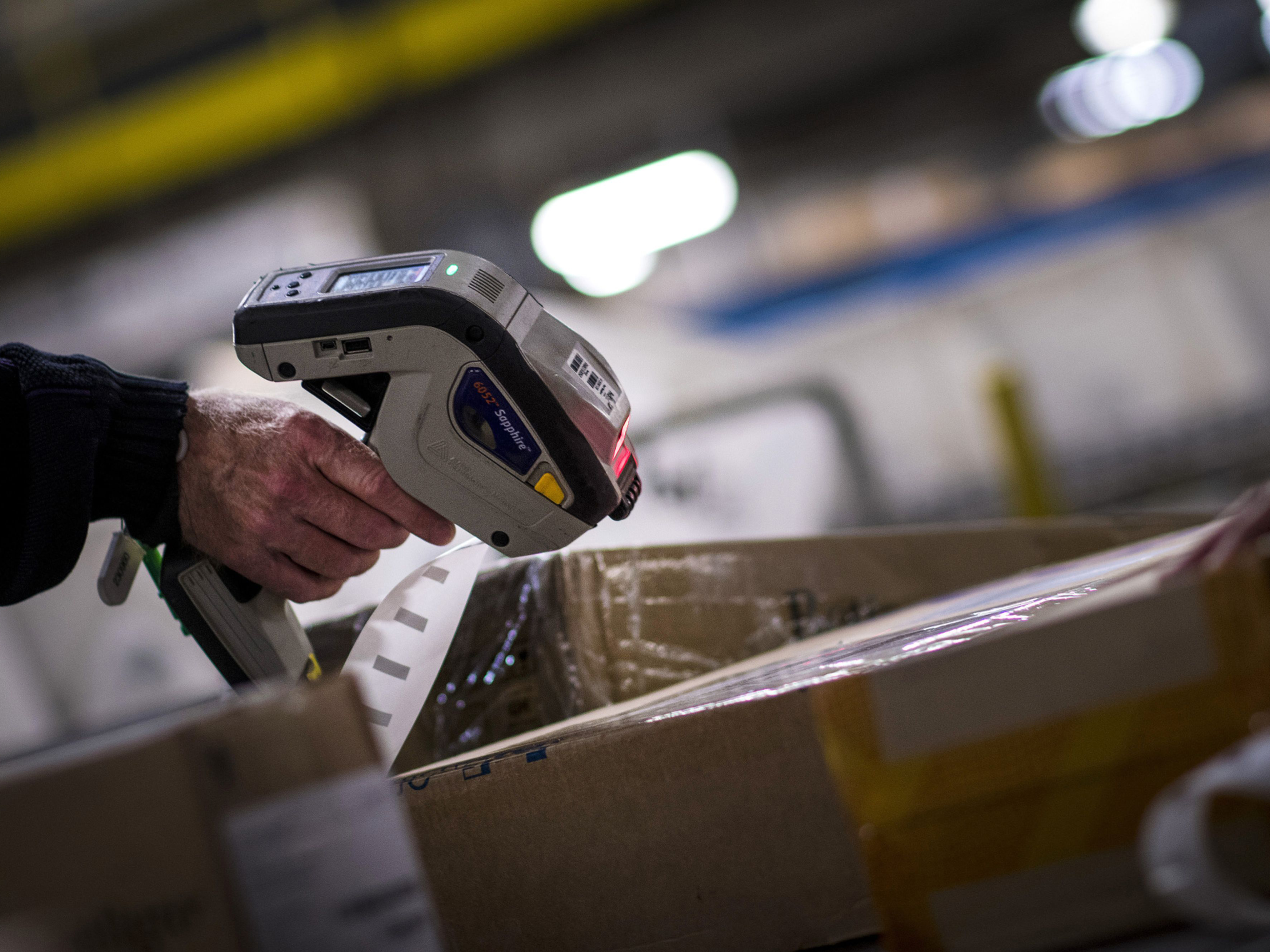
The concept of the barcode — an alphabet made up of thick and thin bars — came into being in the 1950s. It took another quarter of a century for one to be printed on product packaging and scanned. Today, it’s hard to imagine a world without it.
Since it came into widespread use, barcode scanning has become a standard tool in warehouse and retail management, helping businesses keep track of inventory,
determine when to restock and intelligently manage overall operations.
Today there are hundreds of different types of barcodes, each with unique strengths and limitations. Almost $7 billion worth of barcode scanners were sold worldwide in 2020, and the scanner market continues to grow. What was once used for simple code reading has become a way to marry the storage and movement of goods with the global information infrastructure.
As electronic scanning evolves in this way, it’s important to ask the right questions about how to optimize the tool for your business. How are you using your scanners? Are they meeting expectations? Is your workforce happy with them? What matters most in scanner technologies and form factors?
Choosing Scanning Technologies
Different products and markets can have drastically different requirements, necessitating a range of scanning options to choose from. Each business operates uniquely and should favor the barcode and scanning technology optimized for its particular industry or workflow. When considering which technologies are best suited for the company, managers should take into account whether they’ll be using laser or image scanning, what materials the barcodes will be printed on, the environmental conditions of the warehouse, and the needs of warehouse workers.
Whether the warehouse should use lasers or imagers depends on the type of barcode the scanners will be reading. Traditional barcodes are called 1D codes because they consist of a sequence of lines, all with varying thicknesses and distances between each other. 2D codes store data both horizontally and vertically, which increases data capacity. While both are called barcodes, 2D codes may use symbols other than lines and may even utilize color. While barcode symbology represents the data itself, barcode readers identify, scan and decode that data. The most common of these are laser scanners, but they can only read linear barcodes. Imagers work more like cameras and can capture both 1D and 2D codes.
The readability of the barcode is also key. The material it’s printed on, how prone that material is to damage, even the lighting conditions necessary to make out the symbols all affect whether the scanner will be able to accurately read the data. Companies that take these factors into account when choosing their scanning devices avoid the unnecessary errors and costs that come with frequently damaged barcodes or incompatible readers.
Of equal importance is how accessible the scanner is for warehouse users, who often scan hundreds of codes a day. Details such as the placement of scan buttons, touchscreen responsiveness, the weight of the device, battery life, aiming systems and even ergonomics can all impact warehouse efficiency. An optimized scan angle, for instance, may reduce fatigue and repetitive motion injuries, keeping workers healthy and productivity high.
Enabling High-Quality Data Collection
The data collected through barcode scanning can be used for much more than inventory tracking. In order to make the most of this information, scanned data needs to be quickly transmitted to backend systems for logging, processing and real-time analysis. From there, it can be used to gather business intelligence, more effectively control inventory, and optimize warehouse operations.
At the scanner level, this requires not only quick and error-free scanning, but also high-quality wireless data transmission in warehouse environments where coverage and consistent signal strength can be challenging.
At the device level, it requires a robust design that can handle the drops, spills and environmental extremes that will inevitably occur on the job. The ability to clean and disinfect devices without damaging them also remains critical for warehouse safety amid ongoing pandemics. Scanning devices must be able to handle common cleaning agents and be free of nooks and crannies where dirt and bacteria can accumulate. If the device can’t withstand the needs and conditions of the warehouse, it’s useless as a tool for collecting data.
Compatibility can also affect the speed and accuracy of data transmission. In an era where most backend systems run on Microsoft but most handhelds are on Android, it’s important to find a device compatible for both, as well as one that includes sufficient utilities and programming tools to set and fine-tune scanning parameters.
In the 70 years since its conception, barcode scanning has become a defining core technology of modern global commerce. Though deceptively simple, the right tools can be critical to warehouse success, so long as you keep an eye on the details.
Greg Smith is a field applications engineer and scanner expert at JLT Mobile Computers Inc.
The concept of the barcode — an alphabet made up of thick and thin bars — came into being in the 1950s. It took another quarter of a century for one to be printed on product packaging and scanned. Today, it’s hard to imagine a world without it.
Since it came into widespread use, barcode scanning has become a standard tool in warehouse and retail management, helping businesses keep track of inventory,
determine when to restock and intelligently manage overall operations.
Today there are hundreds of different types of barcodes, each with unique strengths and limitations. Almost $7 billion worth of barcode scanners were sold worldwide in 2020, and the scanner market continues to grow. What was once used for simple code reading has become a way to marry the storage and movement of goods with the global information infrastructure.
As electronic scanning evolves in this way, it’s important to ask the right questions about how to optimize the tool for your business. How are you using your scanners? Are they meeting expectations? Is your workforce happy with them? What matters most in scanner technologies and form factors?
Choosing Scanning Technologies
Different products and markets can have drastically different requirements, necessitating a range of scanning options to choose from. Each business operates uniquely and should favor the barcode and scanning technology optimized for its particular industry or workflow. When considering which technologies are best suited for the company, managers should take into account whether they’ll be using laser or image scanning, what materials the barcodes will be printed on, the environmental conditions of the warehouse, and the needs of warehouse workers.
Whether the warehouse should use lasers or imagers depends on the type of barcode the scanners will be reading. Traditional barcodes are called 1D codes because they consist of a sequence of lines, all with varying thicknesses and distances between each other. 2D codes store data both horizontally and vertically, which increases data capacity. While both are called barcodes, 2D codes may use symbols other than lines and may even utilize color. While barcode symbology represents the data itself, barcode readers identify, scan and decode that data. The most common of these are laser scanners, but they can only read linear barcodes. Imagers work more like cameras and can capture both 1D and 2D codes.
The readability of the barcode is also key. The material it’s printed on, how prone that material is to damage, even the lighting conditions necessary to make out the symbols all affect whether the scanner will be able to accurately read the data. Companies that take these factors into account when choosing their scanning devices avoid the unnecessary errors and costs that come with frequently damaged barcodes or incompatible readers.
Of equal importance is how accessible the scanner is for warehouse users, who often scan hundreds of codes a day. Details such as the placement of scan buttons, touchscreen responsiveness, the weight of the device, battery life, aiming systems and even ergonomics can all impact warehouse efficiency. An optimized scan angle, for instance, may reduce fatigue and repetitive motion injuries, keeping workers healthy and productivity high.
Enabling High-Quality Data Collection
The data collected through barcode scanning can be used for much more than inventory tracking. In order to make the most of this information, scanned data needs to be quickly transmitted to backend systems for logging, processing and real-time analysis. From there, it can be used to gather business intelligence, more effectively control inventory, and optimize warehouse operations.
At the scanner level, this requires not only quick and error-free scanning, but also high-quality wireless data transmission in warehouse environments where coverage and consistent signal strength can be challenging.
At the device level, it requires a robust design that can handle the drops, spills and environmental extremes that will inevitably occur on the job. The ability to clean and disinfect devices without damaging them also remains critical for warehouse safety amid ongoing pandemics. Scanning devices must be able to handle common cleaning agents and be free of nooks and crannies where dirt and bacteria can accumulate. If the device can’t withstand the needs and conditions of the warehouse, it’s useless as a tool for collecting data.
Compatibility can also affect the speed and accuracy of data transmission. In an era where most backend systems run on Microsoft but most handhelds are on Android, it’s important to find a device compatible for both, as well as one that includes sufficient utilities and programming tools to set and fine-tune scanning parameters.
In the 70 years since its conception, barcode scanning has become a defining core technology of modern global commerce. Though deceptively simple, the right tools can be critical to warehouse success, so long as you keep an eye on the details.
Greg Smith is a field applications engineer and scanner expert at JLT Mobile Computers Inc.







